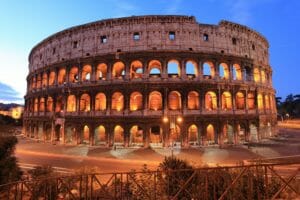Explore Ancient Roman Sites Using Interactive Guidebook

A new interactive guidebook from Citalia shows many ruins and landmarks still standing in modern Italy – as well as the ancient roads that led to where they were built. This allow you to explore from ground level using 360° imagery of the locations, and take a virtual walk amongst the ruins before you visit
Everyone’s heard of the Colosseum, and many will have heard of the Pantheon and the Roman Forum. But have you had a chance to go look at the Arch of Titus? Or the nearby site of Ostia Antica?
Travel down the ancient path of the road known as the Via Appia, from the San Sebastiano gate – once known as the Porta Appia – into Rome, to find the Roman Forum and the Colosseum. Or, head out from the capital in the opposite direction to Pompeii’s lesser-known counterpart Herculaneum, and see the preservation of a fallen city in the ash of Vesuvius.
Keeping it Cost-Effective
If you’re trying to make the most of Rome but don’t have the budget to go to all of the major sites, why not top off your visit with sites like:
- The Arch of Titus – erected in the 1st Century AD, this structure has provided inspiration for major landmarks around the world, including the Arc de Triomphe. The best news? It’s completely free to visit.
- The Aurelian Walls – Although the museum requires a ticket, the still-standing city walls and the San Sebastiano gate are both free – and among Rome’s most impressive sights.
- The Pantheon – Not only one of Rome’s most iconic symbols from history, this ancient temple is also completely free to visit, as it’s still used as a religious centre.
Off The Beaten (Roman) Road
All roads lead to Rome, but there’s also much more of the Roman world to see. Journey beyond the capital into the varied regions of Italy, and you’ll find collapsed amphitheatres, preserved cities, and ancient walls. Explore the map to find sites like:
- Ostia Antica – translating as “ancient mouth”, this harbour city situated close to modern Ostia, near Rome, is now an archaeological site featuring well-preserved buildings and mosaics.
- Paestum – Located near Salerno, Paestum was actually a Greek city. It features three different, well-preserved Greek temples as well as a large number of major structures – making it a great spot to dip into Greek culture on your tour of Ancient Rome.
- The Porta Palatina in Turin – The Palatine Gate is the foremost evidence that Turin was once the Roman city Augusta Taurinorum. It stood as part of the city walls, and stands remarkably firm in the Turin landscape.
- The Verona Arena – one of the best-preserved examples of a Roman amphitheatre still in use in modern times, the Verona Arena now hosts opera performances for up to 15,000 people.
- The Sibyl’s Cave in Cuma – Described in the works of the Roman poet Virgil, this cave near Naples is supposedly the former home of the Sibyl who guided Aeneas to the underworld.
To see the ancient roads of the Roman Empire and the imagery of 85 different landmarks surviving from that time, have a look at the full study here.